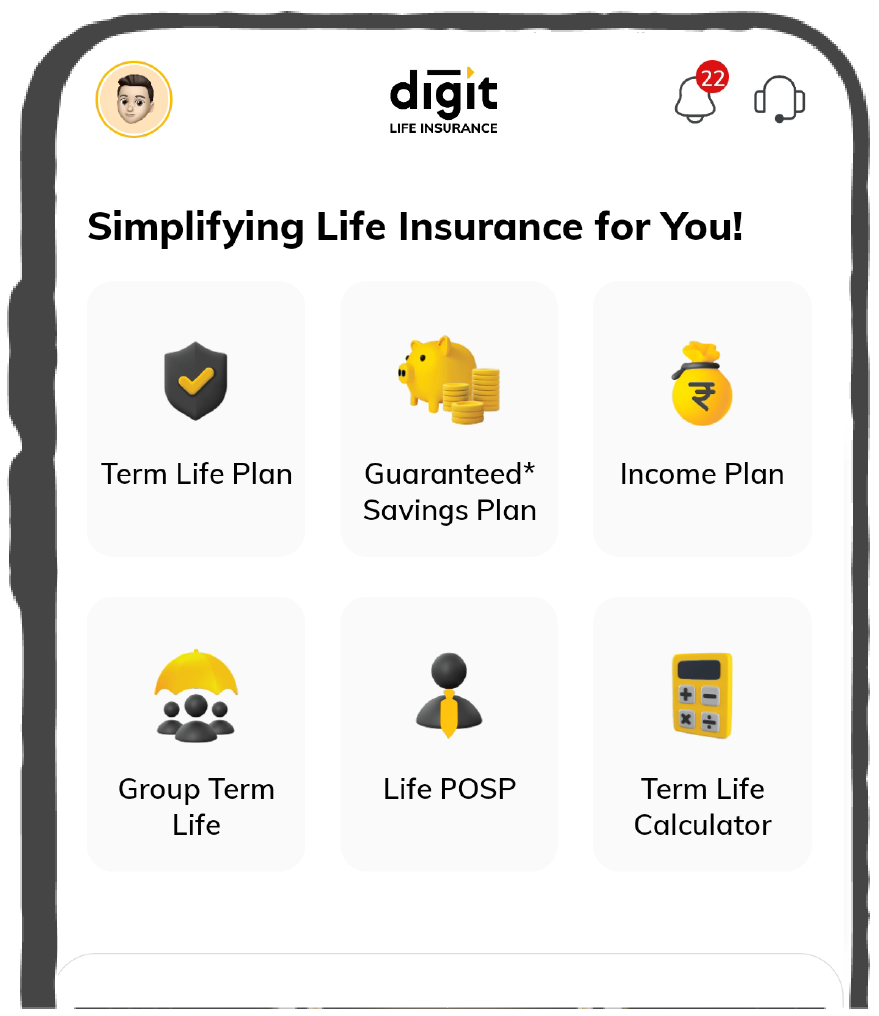Types of Term Life Insurance Plans in India

Term life insurance policies are the most affordable form of life insurance, offering financial security to your family within a fixed duration. Due to its affordable premiums, it is a popular choice of life insurance plan today.
However, you can find numerous types of term insurance, each offering different benefits and terms. Thus, it would be wise to understand what these types include before deciding. Keep reading to learn more about term insurance and its different forms.

Table of Contents

What is Term Insurance & How Does it Work?
A term insurance policy is a financial protection plan that offers coverage within a fixed term. As the name suggests, a term insurance company will offer a death benefit to your beneficiaries in light of your unfortunate demise within the specified period.
However, if the policyholder lives past the coverage period, then their nominees will not be entitled to the death benefit or maturity benefit.
Term insurance plans are a great bargain as they offer a highly assured amount at reasonable premium rates. The large amount ensures financial security for your family, even against the effects of inflation, to meet their future goals along with daily lifestyle expenses.
Moreover, many insurers offer to return the paid premiums if the insured survives past the coverage tenure. Apart from this, the different types of term insurance plans offer benefits under different conditions. Therefore, you must know each type before choosing the most suitable one.
An Example of Term Insurance Working
A 35-year-old employee decides to secure the well-being of his loved ones by purchasing a term insurance plan. He uses a term calculator to determine the premium and opts to pay an amount X annually for 25 years. In the unfortunate event of his untimely death during this period, his nominee will receive a lump sum of ₹1 crore.Different Types of Term Insurance Plans
1. Level Term Plans
Level Term plans are a standard type of term insurance, commonly offered by most insurance companies by default. For this plan, your premium amount and the sum assured are determined at the beginning of the term and remain constant throughout.
Note that premiums for life insurance plans depend prominently on your age. Therefore, if you opt for the policy at a younger age, your premium will also be lower. In addition, factors like your income, health conditions, etc., will also influence the premium rate.
The benefit received on the level-term insurance policy is a death benefit. This means the assured sum will go to your nominees if an unfortunate occurrence leads to your demise. However, no benefit will go to your family if you survive the term period.
Features of Level Term Plan:
- The monthly premium and the assured sum remain unchanged throughout the insurance duration.
- The assured amount can be independently discussed between the insurance provider and the policyholder.
- This insurance allows the nominee to receive the lump sum amount at once after the policyholder's death.
- As per Section 10D of the Income Tax Act, no additional tax is charged against the assured sum.
- This type of insurance plan offers several term plans to choose from.
Who Should Consider Level Term Plan?
The Level Term Insurance Plan is suitable for couples with young children or planning to have children soon. This type of insurance plan enables parents to secure the expenses of their children in their formative years.
2. Term Insurance with Return of Premium (TROP)
Unlike most term insurance plans, Term Insurance with Return of Premium is a type of term plan that offers maturity benefits. Therefore, if you outlive the term of your plan’s coverage, you will still be entitled to the premiums paid until the maturity period. In case you live past the policy term, there will be a 100% refund of the paid premiums, also called survival benefits.
However, this does not mean death benefits are not applied here. So, your beneficiaries will be entitled to receive a death benefit in light of your unfortunate demise within the policy period.
Features of Return of Premium Term Plan:
- TROP involves disbursing the premium policyholders pay if they survive the policy duration.
- It offers certain tax benefits under Section 80C of ITA.
- TROP offers riders the option to enhance the policy.
- TROP offers several payout options.
Who Should Consider Return of Premium Term Plan?
- Single people who wish to secure the well-being of their parents.
- Married people who wish to support their partners financially in the unlikely circumstances of a mishap
- Married individuals who wish to secure the financial status of their children.
3. Increasing Term Plans
As suggested in the name, an increasing term plan refers to that policy where the assured sum amount increases with the passing time at a fixed rate. However, the rate of premium remains relatively constant.
Therefore, the premium of these plans is also relatively steeper. It also depends on the rate at which the assured sum increases. The insurer sets the maximum limit of increase.
Nonetheless, this plan could be helpful during times of inflation to cope with the increasing cost of living. You can also choose this if you expect to increase your financial responsibilities.
Features of Increasing Term Plan:
- The sum assured in increasing term plan insurance increases by a certain percentage depending on the policies and terms of the insurance provider.
- Increasing term plan insurance offers better coverage, providing better financial security.
- This type of insurance plan offers several riders to choose from.
Who Should Consider Increasing Term Plan?
An increasing term plan insurance is ideal for people with increased financial responsibilities.
4. Decreasing Term Plans
A decreasing term plan works opposite to an increasing term plan. This means the assured amount will be reduced at a fixed rate over time. The benefit of this plan is that its premium is significantly low and fixed.
Furthermore, this plan can be beneficial if you have financial debt, such as loans, mortgages, etc. As time passes, the debt amount and the assured amount reduce.
Features of Decreasing Term Plan:
- The amount assured by the insurance provider decreases over the years.
- The premium amount remains the same throughout the tenure.
- A policyholder may decide the tenure of the policy.
- It is a pocket-friendly option that enables individuals to secure their financial stability without any holes in their pockets.
Who Should Consider Decreasing Term Plan?
A decreasing term insurance plan is suitable for those who plan to cover their liabilities, such as home loans and other debts.
5. Convertible Term Plans
Convertible Term Insurance policies refer to those specialised term plans that you can convert into a different type of live coverage plan later on. This means you can turn the term life insurance plan into an endowment plan or whole life insurance if required.
This plan is particularly useful if your financial goals change or you find a better option than your present one. Therefore, if you opt for this type of term insurance and get a whole life insurance or endowment plan after 15 years, you can do it hassle-free.
Features of Convertible Term Plan:
- Policyholders may convert their insurance plans to endowment plans, depending on the terms and conditions of the insurance provider.
- The premium is usually higher than other types of term insurance plans.
- It offers a death benefit and a maturity benefit.
- No additional underwriting is required to assess the risks of the insured.
Who Should Consider Convertible Term Plan?
A convertible term insurance plan is ideal for those individuals whose financial needs and commitments change over time.
6. No-Cost Term Insurance Plans
No-cost term insurance plans provide temporary coverage. Generally, under certain conditions and terms, this policy is exempt from paying premiums, such as when it's converted to a permanent policy or meets health standards. Such insurance offers very affordable protection for those in a quest for short-term solutions.
The following are the common features of no-cost term insurance plans:
- It offers protection for a particular time frame, typically between 10 and 30 years.
- It is much cheaper than whole-life insurance, which makes it available to many.
- The conversion options available to policyholders sometimes allow them to convert into a permanent policy with no medical underwriting at specific times.
- Premiums may be exempted under certain health changes or in cases where there's a conversion into permanent coverage.
Who Should Consider No-Cost Term Insurance Plans?
No-cost term insurance plans will be available for those who want low-cost and short-term coverage, such as families with young children, adults whose financial responsibilities are only temporary, like mortgages, or those wishing to add life insurance coverage without committing themselves to long-term investment.
Factors to Consider While Buying Term Insurance Plans
The Covered Amount
While buying a term plan, one must evaluate the age, financial responsibilities and requirements, lifestyle expenses, inflation, and other crucial factors. These enable an individual to carefully consider the amount he wishes to secure as a cover.Policy Tenure
Depending on age and other financial factors, one should determine the policy tenure he wishes to opt for while purchasing a term insurance plan.Select a Good Insurer
One should carefully conduct research and opt for an insurer whose policies align with one's interests. One must also understand the insurer's market position and other aspects, such as the solvency ratio and claim settlement ratio.How to Choose the Right Term Insurance Plan?
Claim Settlement Ratio
A higher claim settlement ratio enables your loved ones to claim the insurance in your absence without any hassles.Solvency Ratio
A solvency ratio indicates the insurer's capability to provide the assured amount in your absence. A solvency ratio of 1:5 is adequate to determine the insurer's financial stability.Critical Illness Cover
A critical illness cover helps cover the costs during critical illnesses like cancer, brain surgery, etc.Additional Benefits
While most term insurance plans provide coverage for people after the death of the policyholder, some may offer additional protection. These include a waiver for a premium subscription, a regular income benefit, and even an accidental death cover.Tax Benefits of Different Types of Life Insurance
The table below shows the tax benefits on various types of life insurance:
FAQs about Types of Term Insurance
Why should I buy a term insurance policy at an early age?
Which type of term plan has the least premium burden?
Does the term insurance plan offer tax savings benefits?
What if I live past the policy tenure?
What are the three types of term coverage?
How many term insurance plans can I purchase?
Is it possible to change the assured amount for the term insurance plan?
Can I opt for riders for the different types of term insurance policies?
Is a medical test compulsory before purchasing a term insurance plan?
Which type of term insurance plan is cost-effective?
Am I allowed to switch from a level term to a decreasing term insurance?
What is the age limit for term insurance?
How many years is best for term insurance?
What is 20 year term life insurance?
Is there 10 year term life insurance?
Is there a limit for term insurance?
When to stop term life insurance?
Who cannot buy term insurance?
Other Important Term Insurance Guides
Other Important Articles Related to Term Insurance
Latest News
Read More






